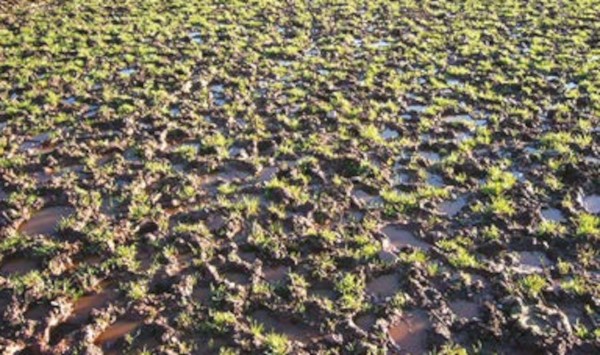- Home
- Knowledge library
- Soil compaction by livestock
Soil compaction by livestock
Damage to grass and the underlying soil can occur when it is trampled by livestock in wet conditions. Here’s how to avoid it.
Introduction
Compaction can be seen where livestock have trampled on wet fields.
The destruction reduces grass growth and can lead to weeds infiltrating the bare areas.
Medium and heavy soils are most susceptible to compaction. Sandy soils, however, are generally less prone to compaction.
Cattle
Cattle can leave 10–12 cm deep compacted depressions or pockets in the surface of the ground (poaching).
Water can lie in these pockets and there may be a layer of grey, smelly, unhealthy soil underneath. These usually emerge in the areas of greatest activity, such as gateways or around drinking troughs and feeders.
This destruction reduces grass growth and allows weeds to infiltrate the bare areas.
Grassland that has been poached by livestock

Sheep
Sheep damage grassland in a different way. They are less likely to break the soil surface, but at high stocking densities they pound the ground as a flock. This can produce a solid compaction layer around 2–6 cm deep over a wide area.
Symptoms
Compaction by livestock can cause:
- Poor crop yield, quality and root growth
- Roots clustered in large pores, worm channels and cracks between aggregates
- A reduced crop response to nitrogen
- Standing water
- Poached, damaged upper layer of the soil and reduced sward density
- A reduction in the number of available grazing days due to colder soil temperature
- A reddish tinge to grass leaves, indicating stress
- Rushes, marsh thistle, creeping buttercup and Yorkshire fog
- Scorch marks from urine patches where urine cannot drain away
- Large angular/platy aggregates (over 5 cm across) with low porosity in the topsoil
- Some red/orange mottling in the soil (sign of poor drainage)
- Soil and fertiliser run-off into watercourses, reducing water quality
Solutions
To understand the extent and nature of the compaction, first dig some holes to look at the soil structure. Then use our simple How to assess soil structure (VESS) guide.
Nature-based solutions
Some soils under grassland have the capacity to recover when compaction is mild, so it is worth monitoring the soil over a period of several months to see if it improves.
Soils can be improved naturally by:
- Clay soils cracking in dry or frosty conditions
- Removing livestock
- Including multi-species swards with varied rooting depths
- Earthworm activity
- Regular application of farmyard manure (following relevant rules and regulations for applying organic materials)
Grazing sheep on rotation in winter (all-grass wintering) cause less damage because they are only on a small area for a short time.
Machinery-based solutions
Where soils do not improve naturally, rectify compaction as soon as soil conditions allow (e.g. by targeted ploughing, subsoiling or sward lifting). This will help water penetrate the soil.
Where compaction is found, you can use a:
- Surface slitter/aerator for compaction between 0–10 cm
- Sward lifter/top-soiler for compaction >10 cm deep
Do not roll severely poached areas.
Cut or graze the site immediately before treatment.
It is important to dig a hole after a cultivator has passed to check it is having the desired effect, rather than causing damage.
How to prevent compaction by livestock
Good soil structure is best maintained by avoiding soil compaction in the first place.
Where possible:
- Remove livestock from wet fields, particularly when grazing forage crops
- Reduce stocking rates
- Increase the length of grazing rotations, particularly in wet conditions
- Outwinter on light, free-draining, well-structured soils
- Strip-graze and back-fence
- Create multiple entry points to fields
- Use dedicated tracks for machinery and moving stock
- Move temporary water troughs and feeders regularly or set up a series of troughs and feeders
- Consider placing permanent troughs on concrete bases
- Feed using a mobile snacker system rather than static troughs
- At harvest, place bales in fields where animals will be fed
- Ensure adequate ground cover is established before pigs are brought on farm, e.g. six months’ grass growth
Recently loosened soil is very sensitive to re-compaction. After loosening:
- Allow the newly loosened structure to be stabilised by root activity and natural soil processes
- Allow at least two weeks before grazing after slitting or sward lifting
- Conserve rather than graze in the first spring after treatment
- If late growth needs utilising, use sheep rather than cattle to minimise re-compaction damage
To reduce the risk of soil loss into watercourses:
- Provide drinking sources, e.g. drinking troughs and pasture pumps
- Fence off watercourses
- Do not feed livestock near watercourses
- Outwinter away from watercourses
- Plan winter feeding in advance
Useful links
Read about how compaction impacts production efficiency and economics
Find out how to assess soil structure
Find out more about grassland cultivation in our Healthy grassland soils pocketbook
Find out about adding organic matter to your soils
See visual case studies of soil compaction by livestock in the Environment Agency thinksoils manual

